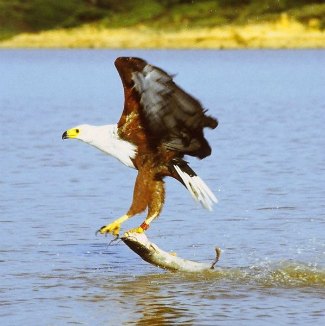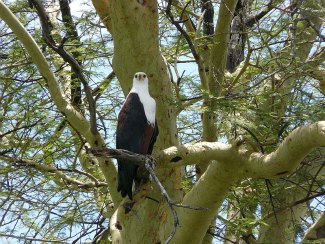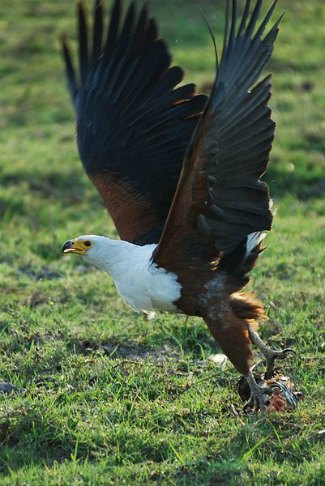African Fish Eagle - Haliaeetus vocifer
By Steve Garvie, CC-BY-SA-2.0, via Wikimedia Commons
Family: Accipitridae
Genus: Haliaeetus
Species: H. vocifer
African Fish Eagles are large raptors with a wide range across sub-Saharan Africa. Brown, white, and black in coloring, they occupy a similar ecological niche to that of Haliaeetus leucocephalus (Bald Eagle) and are closely related to Haliaeetus leucogaster (White-Bellied Sea Eagle), H. sanfordi (Sanford's Sea Eagle), and H. vociferoides (Madagascar Fish Eagle). H. vociferoides is a sister species.
Physical Description:
African Fish Eagles have distinctive plumage with a chestnut body, black wings, and a pure white head, neck, breast, and tail. The face is yellow and featherless and the beak is yellow with a black tip. The feet are yellowish in color and have spiky growths on the bottom that help to grip prey, called spiricules.
Juveniles have a brown body, with a blotchy white head and a black eyeline. They gradually mature over 3-4 years, and the dark streaks that form on the breast are the last of the juvenile plumage to disappear.
African Fish Eagles are noted for their loud calls, which are often heard before the birds can be seen. There are two distinct sounds: when in flight, they emit high-pitched whistling similar to Bald Eagles, but when near the nest, they make a sound closer to "quock", the male being shriller than the female. Their calls have been called "the voice of Africa" and are often heard at dusk. Listen to a recording.
Size:
Length: 63-75 cm
Wingspan: Males: 2 m. Females: 2.6 m
Weight: Males: 2-2.5 kg. Females: 3.2-3.6 kg
By Mehmet Karatay, CC-BY-SA-3.0, via Wikimedia Commons
Habitat and Distribution:
They are found in coastal estuaries and lagoons, but their habitat is usually rivers, lakes, dams, and pans, or other places where there are stretches of water and trees where they can perch. They usually live at 1,500 meters above sea level but have been recorded up to 4,000 m.
They occur across sub-Saharan Africa (south of 16°N) from western Africa to Ethiopia and down to South Africa, except for southwestern Africa and Somalia, where it is arid; instead they concentrate around Rift Valley lakes such as Lake Victoria in the east. Some African Fish Eagles are irruptive or local migrants and move around to avoid wetter weather, but others remain in the same place year-round. There are approximately 300,000 individuals over a range of 18,300,000 km².
Diet and Hunting:
As their name would suggest, their main diet is fish, and it constitutes 90% of what they eat. Some of their catch is carrion, but most of their food is caught live. They can catch prey up to 1 kg in weight and have been known to bring in fish up to 3 kg; anything over 1.8 kg is dragged along through the water to shore. Catfish and Lungfish are the most commonly caught animals, but they have been known to eat dassies (also known as Rock Hyraxes), monkeys, monitor lizards, frogs, terrapins, insects, and even crocodile hatchlings. They also go after other birds such as ibises, spoonbills, storks, herons, and Greater and Lesser flamingos. In addition, they are kleptoparasites, meaning they steal food from other animals; Ardea goliath (Goliath Heron) are known to lose a percentage of their catch to African Fish Eagles. They also raid the nests of waterbirds for eggs and young.
They usually still-hunt from a perch and swoop down, catching the prey within 15 cm of the water's surface. They don't often submerge underwater, or hunt from the air, behavior observed in other eagles. They are capable of surviving on only 10 minutes of active hunting a day, and a single pair may need less than a square kilometer of water, if food is abundant. If they are next to a river, someplace where there is less food, they may need a stretch of over 25 km. Pairs are known to share kills.
By tylerni7, CC-BY-SA-2.0, via Wikimedia Commons
Reproduction:
The breeding season varies by region: close to the equator they will breed at any time, but in southern African the season is from April-October, in the eastern coastal regions June-December, and in the western areas it is from October-April. Displays consist of soaring and calling and occasional claw-grappling. Pairs are found year-round and probably mate for life.
The nest is 120-180 cm in diameter and 30-60 cm thick and made out of sticks and other pieces of wood. It is usually built in the fork of a tree, but is sometimes placed on a cliff ledge or along a steep slope where there is low bush. Pairs often have two or more nests, which grow in size after consecutive years of use. 1-3 white and speckled eggs are laid at three-day intervals. Most of the incubation is done by the female, but the male will sit on the nest when she hunts. Incubation takes 42-45 days. The eldest sibling usually kills any younger chicks, behavior known as siblicide, or Cainism. Fledging lasts for 64-75 days and the young will leave the nest two weeks after that.
Conservation:
African Fish Eagles have been listed as Least Concern by BirdLife International due to their large range and apparently stable population.
Taxonomy:
Haliaeetus vocifer is closely related to Haliaeetus leucogaster (White-Bellied Sea Eagle), H. sanfordi (Sanford's Sea Eagle), and H. vociferoides (Madagascar Fish Eagle), and is a sister species to H. vociferoides.
Haliaeetus comes from the Greek word hals for "sea" or "salt" and aetos which means "eagle". Vocifer comes from the Latin word vocifero, which means "cry aloud".
Other Names:
River Eagle, Fish Eagle, Visarend (Afrikaans), Orel jasnohlasý (Czech), Afrikansk Flodørn (Danish), Afrikaans zeearend (Dutch), Kilg-merikotkas (Estonian), Kiljumerikotka (Finnish), Pygargue vocifer (French), Schreiseeadler (German), Glymörn (Icelandic), Aquila pescatrice africana (Italian), Sanshokuumiwashi (Japanese), Bielik afrykanski (Polish), Skrikhavsörn (Swedish), Nghunghwa (Tsonga), Kgoadirê (Tswana), Ingqolane, Unomakhwezana (Xhosa), iNkwazi (Zulu).
Heraldry:
The African Fish Eagle is the national bird of Namibia, Zambia, and Zimbabwe, and appears in the coat of arms of Namibia, South Sudan, and Zambia.
Video of an African Fish Eagle:
References:
http://avibase.bsc-eoc.org/species.jsp?avibaseid=A19B0CF4A0D54658
http://www.biodiversityexplorer.org/birds/accipitridae/haliaeetus_vocifer.htm
http://www.birds.com/species/a-b/african-fish-eagle/
BirdLife International (2012) Species factsheet: Haliaeetus vocifer. Downloaded from http://www.birdlife.org on 22/05/2012.
http://www.camacdonald.com/birding/CountryIndex.htm
Global Raptor Information Network. 2012. Species account: African Fish Eagle Haliaeetus vocifer. Downloaded from
http://www.globalraptors.org on 22 May. 2012
http://www.goss-online.org/magnoliaPublic/en/about/symbols.html
BirdLife International 2009. Haliaeetus vocifer. In: IUCN 2011. IUCN Red List of Threatened Species. Version 2011.2.
www.iucnredlist.org. Downloaded on 22 May 2012.
http://www.kenyabirds.org.uk/fish_eagles.htm
http://lazoo.org/animals/birds/eagle_africanfish/index.html
http://learner.org/courses/envsci/unit/text.php?unit=4&secNum=7
http://www.namibian.org/travel/birds/african-fish-eagle.html
http://www.naturalencounters.com/raptors.html
http://www.ngw.nl/int/afr/zam/zm-nat.htm
Ferguson-Lees, James, and Christie, David A. Raptors of the World. Houghton Mifflin Company, 2001.
http://www.sa-venues.com/wildlife/birds_african_fish_eagle.htm
http://www.thebookingcompany.net/botswana/birds-botswana/fish-eagle
http://www.thekruger.com/knpbirds/haliaeetusvocifer.htm
http://www.wilkinsonsworld.com/tag/african-fish-eagle/



